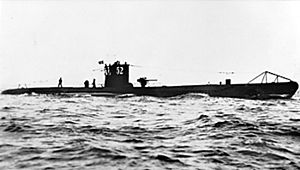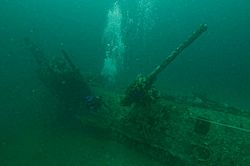German submarine U-85 (1941) facts for kids

U-52, a typical Type VIIB boat
|
|
Quick facts for kids History |
|
|---|---|
| Name | U-85 |
| Ordered | 9 June 1938 |
| Builder | Flender Werke, Lübeck |
| Yard number | 281 |
| Laid down | 18 December 1939 |
| Launched | 10 April 1941 |
| Commissioned | 7 June 1941 |
| Fate | Sunk by USS Roper, 14 April 1942 |
| General characteristics | |
| Class and type | Type VIIB U-boat |
| Displacement | |
| Length | |
| Beam |
|
| Draught | 4.74 m (15 ft 7 in) |
| Installed power |
|
| Propulsion |
|
| Range | |
| Test depth |
|
| Complement | 4 officers, 40–56 enlisted |
| Sensors and processing systems |
Gruppenhorchgerät |
| Armament |
|
| Service record | |
| Part of: |
|
| Commanders: |
|
| Operations: |
|
| Victories: | Three commercial ships sunk (15,060 GRT) |
|
|
|
| Nearest city | Nags Head, North Carolina |
| MPS | World War II Shipwrecks along the East Coast and Gulf of Mexico MPS |
| NRHP reference No. | 15000805 |
| Added to NRHP | 12 November 2015 |
The German submarine U-85 was a special type of U-boat used by Nazi Germany's navy, called the Kriegsmarine, during World War II. U-boats were submarines that played a big role in naval battles.
U-85 was built in Lübeck, Germany. Its construction began on December 18, 1939. The submarine was launched into the water on April 10, 1941. It officially joined the German Navy on June 7, 1941. Lieutenant Eberhard Greger was its first and only commander.
During its time in service, U-85 went on four war patrols. It successfully sank three enemy ships. However, its journey ended in April 1942. The American destroyer Roper sank U-85 off the coast of the United States.
The U-85 Submarine: A World War II Story
What Was the U-85 Like?
U-85 was a Type VIIB U-boat. This was a common type of submarine used by Germany during the war. These submarines were designed to be strong and effective in battle.
How Big Was It?
When U-85 was on the surface, it weighed about 753 tons. When it was underwater, it weighed 857 tons. The submarine was about 66.5 meters (218 feet) long. That's longer than two basketball courts! Its widest part, called the beam, was about 6.2 meters (20 feet).
The submarine was powered by two diesel engines for moving on the surface. These engines gave it a top speed of about 17.9 knots (33 kilometers per hour). When underwater, it used electric motors. Its submerged speed was about 8 knots (15 kilometers per hour). U-85 could travel about 8,700 nautical miles (16,100 kilometers) on the surface without refueling. Underwater, it could go about 90 nautical miles (167 kilometers). It could dive to depths of up to 230 meters (750 feet).
What Weapons Did It Have?
U-85 was well-armed for its missions. It had five torpedo tubes. Four were at the front (bow) and one was at the back (stern). It carried 14 torpedoes. Torpedoes are underwater missiles used to sink enemy ships.
The submarine also had a large deck gun, which was an 8.8 cm (3.5 inch) naval gun. This gun could fire 220 rounds. For defense against airplanes, it had a 2 cm (0.8 inch) anti-aircraft gun. A crew of about 44 to 60 sailors operated the submarine.
U-85's War Journeys
U-85 completed four patrols during its service. Each patrol was a dangerous mission in the Atlantic Ocean.
First Patrol: A Successful Start
U-85 began its first patrol on August 28, 1941. It left from Trondheim in Norway. On September 10, 1941, it found and sank a British ship called Thistleglen. This happened northeast of Cape Farewell, near Greenland. After this success, U-85 returned to Saint-Nazaire on the French coast on September 18.
Second and Third Patrols
The second patrol of U-85 started and ended in Lorient, another French port. This patrol was not as eventful as the first.
On its third patrol, U-85 had another success. On February 9, 1942, it sank the British ship Empire Fusilier. This happened southeast of St. Johns, Newfoundland. The submarine chased the ship for seven hours before sinking it. Sadly, nine crew members from the Empire Fusilier were lost.
Final Patrol and Loss
U-85 left St. Nazaire for its fourth and final patrol on March 21, 1942. On April 10, it sank a Swedish cargo ship named Christina Knudsen off the coast of New Jersey in the United States.
Just four days later, on April 14, 1942, U-85 was sunk. It was near Cape Hatteras off the US coast. The American destroyer Roper attacked it with gunfire. All the sailors on board U-85 were lost. This was the first German U-boat sunk during "Operation Drumbeat". This was a German U-boat attack along the eastern coast of the United States in 1942.
What Were Wolfpacks?
U-85 was part of groups of U-boats called "wolfpacks". These were groups of submarines that hunted together. They would attack enemy convoys (groups of merchant ships) to sink as many as possible. U-85 took part in four wolfpacks:
- Markgraf (September 1–11, 1941)
- Schlagetot (October 20 – November 1, 1941)
- Raubritter (November 1–17, 1941)
- Störtebecker (November 17–22, 1941)
The Sinking of U-85
On the night of April 13, 1942, U-85 was operating near Bodie Island Light. The US destroyer Roper detected the submarine using its radar. The Roper was about 2,700 yards (2,469 meters) away.
U-85 tried to escape by moving south on the surface. As the Roper got closer, U-85 fired a torpedo from its stern. But the Roper managed to avoid it. When the Roper was only 300 yards away, U-85 turned sharply.
The Roper used its searchlight to light up the U-boat. Sailors on the deck of U-85 were seen near its gun. The Roper then fired its machine guns and hit U-85 with a 3-inch gun. After the U-boat went underwater, the Roper dropped 11 depth charges. Depth charges are bombs designed to explode underwater and damage submarines.
After the attack, many men were seen in the water. However, no rescue attempts were made until daylight. By then, no survivors were found among the crew. The bodies were later identified and buried at the Hampton National Cemetery. The U-85 wreck lies in less than 100 feet (30 meters) of water. The United States Navy tried to salvage it briefly.
Discovering the Wreck Today
The wreck of U-85 is still on the seabed. It is a popular spot for divers to explore. The hatch of U-85 is on display at the Graveyard of the Atlantic Museum. This museum is in Hatteras, North Carolina.
The strong Labrador current can make the water cloudy at the wreck site. Most of the submarine's parts are within 100 meters (328 feet) of the main wreck. In 2015, the wreck site was added to the National Register of Historic Places.
An Enigma machine was found on the wreck by private divers. An Enigma machine was a device used by the Germans to send secret coded messages. In 2003, the German government allowed this machine to be shown at the Graveyard of the Atlantic Museum.
Ships Sunk by U-85
U-85 sank three commercial ships during its patrols. Here is a list of them:
| Date | Ship | Nationality | Tonnage | Fate |
|---|---|---|---|---|
| 10 September 1941 | Thistleglen | 4,748 | Sunk | |
| 9 February 1942 | Empire Fusilier | 5,408 | Sunk | |
| 10 April 1942 | Chr. Knudsen | 4,904 | Sunk | |
| Total Tonnage Sunk = | 15,060 | |||
Images for kids





